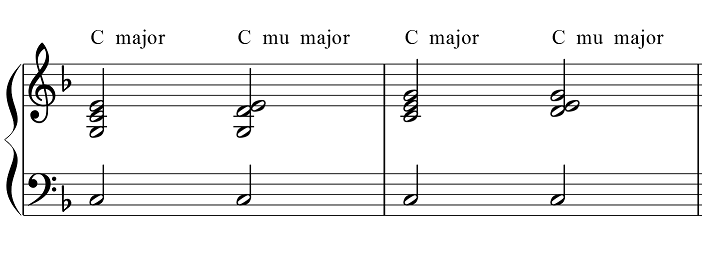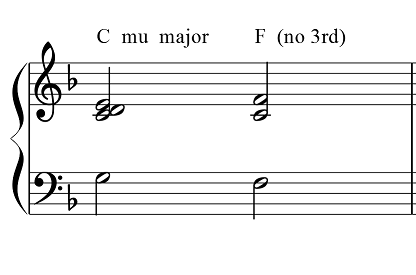The Birth of the Mu Major Chord in 12th Century Paris
by Howard Wright
The “mu major chord” will be familiar to most Steely Dan fans as a spiced-up version of the plain major chord, used extensively by Donald and Walter in their songwriting. But the birth of this chord, which can be traced all the way back to 12th century Paris, is perhaps not so well known…
What’s in a Name?
Steely Dan’s use of the mu major chord in their jazz-influenced progressions is evident from their earliest to their most recent albums. As Donald and Walter themselves explained (http://www.steelydan.com/songbook.html), the mu major chord was “the most frequently used stylistic device in the arsenal of music effects responsible for defining and maintaining the distinctive Steely Dan sound”.
To create a mu major you take a major chord and substitute a second-degree note for a tonic note in the upper part of the chord. So with C major you’d swap one of the C notes for a D, transforming C major, e.g. C + G + C + E, into C mu major, C + G + D + E (see first bar in Figure 1). Voicings, like this one, that result in a whole-tone dissonance between the second and third would typically be favoured.

Musicians familiar with the chord before the days of Steely Dan would probably have known it as an “add 2” chord (since it’s formed by adding the second to a major chord). Apart from their favouring of specific chord voicings, the main innovation that Donald and Walter introduced was the name “mu major”.
Prior to Steely Dan there were many other artists already using the chord, including Joni Mitchell, Nick Drake, The Beatles, Frank Zappa, not to mention classical composers such as Debussy and Stravinsky. So how far back in history do we have to go to find the earliest documented use of the mu major chord? Step into the time machine and hold on tight: we’re heading back to medieval Europe. You won’t believe the shoes…
Early Medieval Polyphony
Early medieval music was very much simpler and plainer than today’s music, with melodic lines usually having little or no supporting harmony. Apart from court musicians and troubadours, it was the devotional plainsong of the church that defined the musical landscape of the time. This plainsong was strictly monophonic, consisting of a single unaccompanied melody. Experiments with the single melodic lines of Gregorian chant, and the first steps towards polyphony, began in the late 9th century when a second voice was added, singing in parallel with the primary melody, usually in perfect fourths or fifths.
One of the key figures in the later development of this style of music, called “organum”, was Léonin, who freed the second voice from having to strictly follow the exact rhythmic and melodic contours of the original melody, opening the door to more varied harmonies. But it was his pupil and successor Pérotin who took even bolder steps, revolutionising the harmony of the times, and leading to the first documented use of the mu major chord.
Pérotin the Master
Both Léonin and Pérotin lived and worked in Paris in the late 12th century, and much of their music is linked to the Notre Dame Cathedral. Léonin is credited with the creation of the “Magnus Liber Organi” or “Great Book of Organum”, a landmark work that documented the state of the art of this two-voice style of singing. Many of Léonin’s compositions used a technique where the original plainchant melody would be greatly stretched out, with each syllable of the original text being sung over a long held note, while the second voice provided harmonic interest by singing more rapidly changing musical phrases above the slow plainchant melody.
Pérotin added to the “Magnus Liber”, most significantly with his pioneering creation of works for three and four voices (“organum triplum” and “organum quadruplum”). These also used very long notes in the tenor voice, which followed the original melody, while the other voices moved more quickly and freely above.
Everything in Moderation
It’s worth emphasising how the conservative tastes of the church placed great restrictions on what was deemed acceptable musical innovation. New compositional techniques would only be permitted if they were seen to glorify and build on existing music that had already been accepted by the church. Pushing back musical boundaries without paying careful respect to existing sacred melodies would have been frowned upon. Adding a second voice to a plainchant, let alone a third or fourth, might have been rejected as unsuitable for the church, unless the character of the original melody was maintained and not obscured.
One commentator, John of Salisbury, writing about the evolving musical styles of the 12th century, described this need to balance harmonic innovation with appropriate restraint:
“When you hear the soft harmonies of the various singers, some taking high and others low parts… you would think yourself listening to a concert of sirens rather than men… When this goes to excess it is more fitted to excite lust than devotion; but if it is kept in the limits of moderation, it drives away care from the soul and the solicitudes of life, confers joy and peace and exultation in God, and transports the soul to the society of angels”.
The First Mu Major
Pérotin’s composition Viderunt Omnes is the earliest piece of music we know of that used four independent voices singing in harmony. At a time when the use of even a second voice singing harmonies was a recent innovation, it’s hard to imagine the incredible impact of hearing polyphonic music in four voices for the first time. And at Notre Dame on Christmas Day 1198, at the first performance of Viderunt Omnes, the first composition using four-part polyphony, we find the first ever mu major chord. What an incredible quirk of history to learn that this quintessential Steely Dan chord was first heard over 800 years ago at the very birth of polyphonic music!
The mu major chord appears several times during Viderunt Omnes, but always as the chord immediately preceding a strongly consonant chord used to mark a change in one of the long notes in the “stretched” plainchant melody. Note that what was judged pleasing and consonant during medieval times was very different to today’s tastes. In the 12th century, octaves, perfect fourths and perfect fifths were judged to be the consonant intervals, and so it is chords made up of these intervals that were used to mark key points in the music, typically the start or end of each syllable sung over the long notes of the plainchant melody. The 12th century rules governing cadences involving these consonant chords typically allowed only stepwise motion of each of the voices. In other words, each voice could only move up or down one note of the scale to arrive at the note producing the desired consonant chord.
The most striking appearance of the mu major chord in Viderunt Omnes is in the cadence sung for the second syllable of the word “Omnes”:
The second chord of the cadence is, from low to high, F C C F, using intervals of a fifth, fourth, unison and octave. The “stretched melody” stays on the note C, and the three other voices each move by one step in the F major scale: G to F, D to C, E to F. This produces a cadence with a C mu major chord resolving to an F chord with no third: G + C + D + E resolving to F + C + C + F (see Figure 2). The same two-chord cadence appears elsewhere in the piece, but at bar 87 (transition to the second syllable of “Omnes”) the dynamics give it a particularly dramatic presence.

Evolution of Dissonance
Mu major voicings like this, featuring two major-second dissonances (between C and D, D and E), are rarely used by Steely Dan, who typically favour just a single major-second dissonance. But cluster-style mu major chords very similar to the one in Viderunt Omnes do feature on some Steely Dan tracks (for example in the Michael Omartian piano parts on Katy Lied).
Given the very different perceptions of consonance in the 12th century, we can only speculate on how the mu major chords in Viderunt Omnes would have been perceived. A brief, unpleasant dissonance that leads to the soothing consonance of the next chord? Or did Pérotin and others find the unusual dissonances pleasing? It’s impossible to know for sure.
And could Pérotin have possibly dreamed that, when introducing the revolutionary idea of four voices singing in harmony, he had composed a chord that at the time was merely an unusual by-product of the 12th century rules for cadences, but would later become a favoured dissonance some eight centuries later? We will never know, but since he gave birth to the first ever mu major chord, Steely Dan fans should certainly be grateful to this 12th century musical revolutionary.
Links and further information
Introduction to the Steely Dan Song Book: http://www.steelydan.com/songbook.html.
Explanation of the Steely Dan mu major chord: http://www.hakwright.co.uk/steelydan/mu-major.html
Pérotin’s Viderunt Omnes (performed by the Hilliard Ensemble), video with sheet music:
Listen to the strongest cadence with a mu major chord in Viderunt Omnes (after 3m 40s):
